ApniPathshala Annual Report 2024: A Year of Impact, Growth & Change
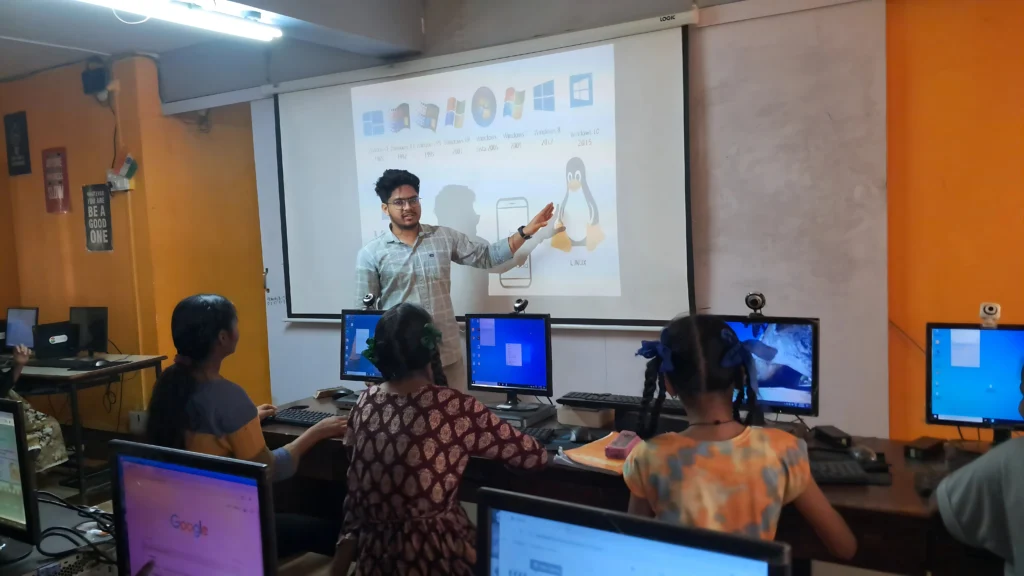
If you walked into one of our learning PODs today, you’d see something incredible. A 12-year-old girl coding her own game. A teenager managing an entire learning center. A group of kids who once struggled with computers now teach others how to use them. This isn’t just education, it’s a revolution. In 2024, Apni Pathshala didn’t just expand—we changed lives. From launching new PODs to helping students become self-sufficient digital learners, this year has been one of impact, growth, and breaking barriers. Let’s take a look at what we’ve built together. Our Mission & Vision At Apni Pathshala, we believe that education is the key to empowerment. Our mission is simple but powerful: Our vision is simple: a digitally literate India where learning isn’t just about getting a degree but about building something meaningful. We want to empower young entrepreneurs to run their own PODs turning them into growing spaces of knowledge, growth, and opportunity. And the beauty of it? When one student succeeds, they lift others with them. It’s about creating a community where knowledge, success, and opportunities keep flowing—person to person, POD to POD, shaping a better future for everyone! What We Achieved in 2024? But numbers only tell part of the story. The true impact lies in the lives we’ve touched. Stories That Inspire Vedika (Atma Foundation POD) – The 12-Year-Old Game Developer At just 12 years old, Vedika isn’t just learning to code—she’s creating her own games using Scratch and Python. What started as curiosity has turned into a full-blown passion. She now dreams of becoming a software engineer, proving that when given the right tools, kids don’t just learn, they innovate. Nikhil (CSC Patel Nagar POD, Delhi) – The Teenage Mentor Nikhil is a Class 12 student with a leadership mindset. He manages an entire POD, overseeing the daily learning of 30+ students. Despite his responsibilities, he continues to upskill himself through advanced courses. His story is proof that education is not just about learning, it’s about lifting others along the way. Kalpavriksha Seva Trust POD – A Student-Led Revolution This isn’t just a POD—it’s a movement. The students who once came here to learn are now running the POD themselves. From teaching new learners to managing daily operations, this POD has proven that empowered students become future leaders. The Launch of the Apna PC Initiative We’ve all heard it—“Access to technology can change lives.” But what if a child wants to learn to code, build projects, or explore the internet, and there’s no computer at home? That’s where Apna PC comes in. What is Apna PC?A game-changer for students who dream big but lack resources. We provide affordable, high-quality refurbished PCs so that learning doesn’t stop when they leave a POD—it continues at home. Why Does It Matter? For many kids, this isn’t just about a computer—it’s about a future they never thought possible. With Apna PC, we’re ensuring that every home can be a learning space. Challenges We Faced & Overcame There are always two sides of a coin- if you have great aims, you are bound to face challenges. As they say, every great journey comes with its hurdles, here’s what we handled this year: So you see, every challenge was a stepping stone in disguise! Apni Pathshala 2.0: How is it different from AP 1.0? Apni Pathshala 1.0 laid the foundation. It was all about bringing digital literacy to underserved communities. But Apni Pathshala 2.0? More than an upgrade, it’s a revolution. A bigger, bolder, and better version of everything we’ve built so far. 🔹 Structured for Success – In 1.0, we launched learning PODs. In 2.0, we nurture, support, and ensure they become self-sustaining. Each POD now follows a 15-month structured roadmap, moving from setup to full independence. No more guesswork. No more uncertainty. Just clear steps toward lasting impact. 🔹 Beyond the Basics – In 1.0, students learned how to use digital tools. In 2.0, they master AI, cybersecurity, and data science. We’re not just teaching digital literacy anymore, we’re building future-ready innovators. 🔹 From Learning to Leading – 1.0 gave students knowledge. 2.0 gives them power. With the Brand Ambassador Program, students don’t just learn—they lead. They don’t just consume knowledge—they spread it. They don’t just study—they mentor, advocate, and build their communities. 🔹 Scaling Like Never Before – Apni Pathshala 1.0 was big. But 2.0? It’s massive. We’re scaling to 150+ active learning PODs by the end of 2025, ensuring more students, more impact, and more lives transformed. Apni Pathshala 2.0 isn’t just a new version. It’s a movement. A movement that takes everything we did in 1.0 and makes it bigger, stronger, and more impactful. Because education isn’t just about learning—it’s about changing lives, creating leaders, and shaping the future. How Can You Help? To keep growing, we need YOU. If you believe in equal digital education for all, here’s how you can make a difference: Donate – Help fund more PODs and provide digital resources to students.Volunteer – Share your time, mentor a student, or contribute your skills.Partner with Us – Bring Apni Pathshala to more communities. Join the movement today! Visit ApniPathshala and contact us to learn more. Together, we can build a digitally literate India and transform lives—one POD at a time.
ApnaPC: Bringing Technology to Every Indian Home
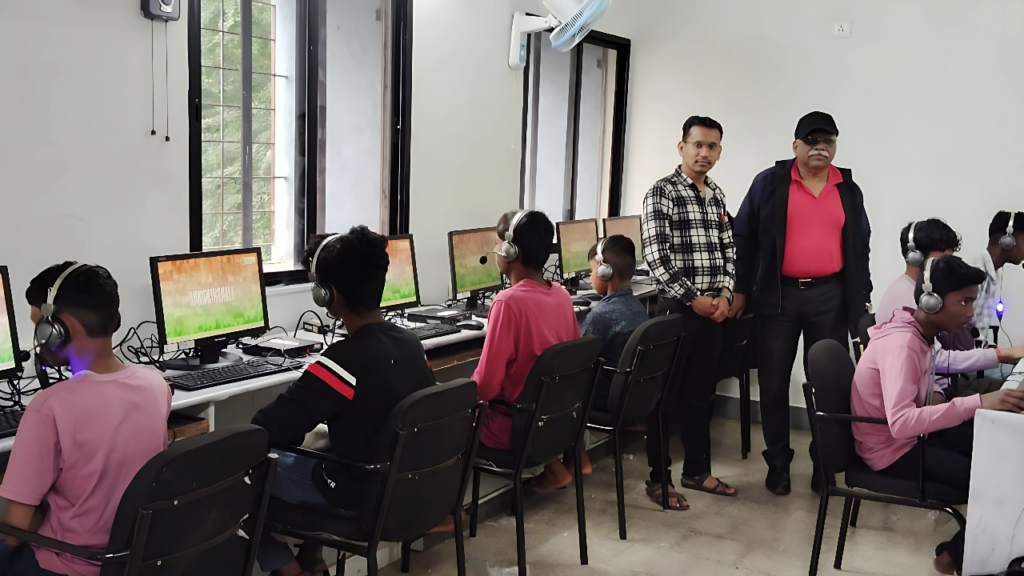
Let’s imagine a world where every student, teacher, and professional has the tools they need to chase their goals. Sounds ideal, right? But for many families in India, owning a computer feels like an impossible dream—something only a few can afford. At Apni Pathshala, we believe that every child deserves a chance to dream bigger. That’s why we created ApnaPC—a computer designed to empower learners, bridge gaps, and unlock potential. Through this Q&A, we’ll explore everything about ApnaPC and how it’s changing lives across the country. 1. What is ApnaPC, and why was it created? ApnaPC is a specially designed computer created by Apni Pathshala to help learners—students, teachers, and professionals—access affordable technology. We noticed a huge problem: many students in India don’t have access to computers, making it hard for them to learn, grow, or compete in the digital world. ApnaPC solves this by providing a high-quality computer at minimal cost, equipped with all the tools needed for education and skill-building. 2. When did the ApnaPC initiative start? The ApnaPC initiative was officially launched on January 1, 2025. Since then, it has been transforming the way people in India access education and technology. 3. Who can apply for ApnaPC? Currently, ApnaPC is available to learning pods and community leaders who use these computers to teach and support others in their communities. This ensures that ApnaPC benefits large groups of learners. In the future, we plan to expand our initiative, allowing individual students and families to apply through a Google form. This form will let us understand your needs and assess how we can help you. 4. How can I apply for ApnaPC? As already mentioned above, as of now, ApnaPC is available to learning pods and community leaders. They can apply through our initiative to receive computers for their programs. In the future, we’ll introduce a Google form application process, where individuals can share their requirements and proposals to qualify for ApnaPC. Stay tuned for updates! 5. Why is ApnaPC so affordable? We believe education should not depend on a family’s financial situation. ApnaPC is budget-friendly because we want to make technology accessible to everyone. While similar computers cost ₹30,000–₹40,000, ApnaPC is offered at a much lower price with no rental fees. 6. What’s inside an ApnaPC? ApnaPC is more than just a computer—it’s a complete setup designed for learning. Each ApnaPC includes: 7. What are the different ApnaPC models? We’ve designed two models to meet different needs: 8. What tools and apps come with ApnaPC? ApnaPC comes preloaded with amazing tools to make learning exciting: 9. How is ApnaPC helping India’s digital growth? India’s biggest challenge is bridging the gap between urban and rural education. By making technology affordable and accessible, ApnaPC is: 10. How durable is ApnaPC? ApnaPC is built to handle tough conditions. 11. What is Apni Pathshala’s ultimate vision? Our vision is to bring digital growth and literacy to every corner of India. We want to ensure that no student or learner is left behind because of a lack of resources. Through ApnaPC, we hope to build a future where technology is accessible, education is inclusive, and every dream has a chance to come true. 12. What’s next for ApnaPC? We’re constantly working to make ApnaPC better and more accessible. Our future plans include: 14. Why should you choose ApnaPC? ApnaPC is not just a computer, it’s a tool for empowerment. Here’s why it’s the right choice: Be Part of the Change! ApnaPC is more than a product—it’s a mission to create opportunities, break barriers, and bring technology to every Indian home. Whether you’re a student, teacher, or community leader, ApnaPC is here to help you achieve your dreams. Contact Apni Pathshala to start your journey today with ApnaPC! Together, we can build a brighter future for India.
Community micro-schools: Top Challenges and How to Solve Them
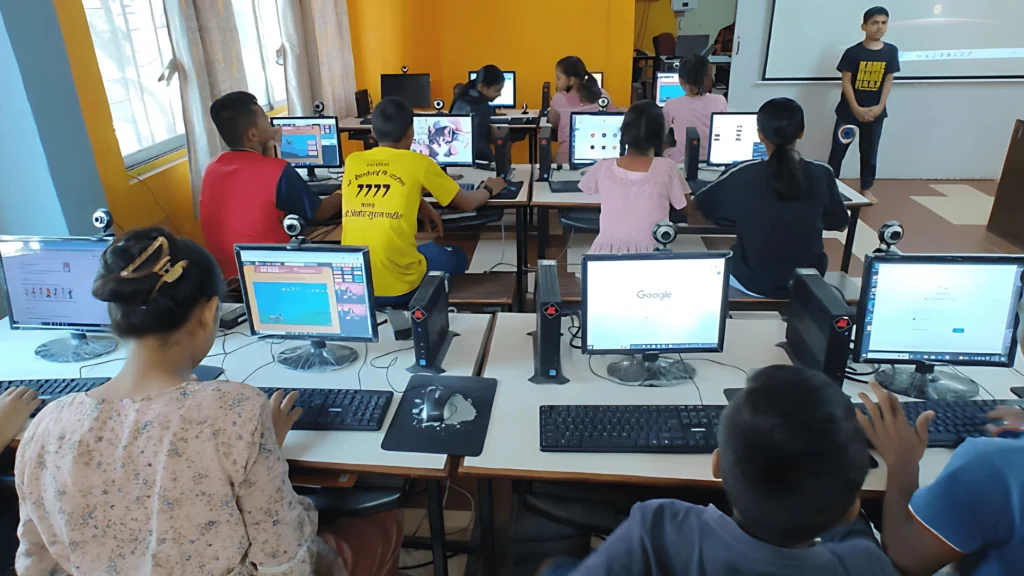
Every parent wants the best for their child, especially when it comes to education. Right? But sometimes, the traditional school system feels like it’s missing something. That’s why community micro-schools are gaining attention—they offer a more personalized and student-centered approach to learning. However, starting or joining a micro-school isn’t as simple as it sounds. Whether it’s dealing with tight budgets, regulations, or figuring out how kids will turn out, the challenges are real. But here’s the thing: they’re also solvable. So to help you out, we’ll explore the most common struggles of community micro-schools and provide practical, actionable solutions. By the end, you’ll feel more confident about embracing this innovative approach to education. Let’s start. 1. Funding Challenges for Microschools Let’s start with the most basic yet most important part: money. Running a microschool costs more than you think. Whether it’s paying teachers, buying supplies, or renting a space, the expenses add up fast. What You Can Do? 2. Rules and Regulations Every region has different rules about what a school can and can’t do. And for micro-schools, the rules are often unclear. Is it a homeschool? A private school? Somewhere in between? So, things can get messy sometimes. You need to manage these things beforehand otherwise you never know what problem can arise. How to Handle It? 3. Finding and Keeping Great Teachers Thirdly, one of the hardest parts of running a micro-school is finding passionate, qualified teachers who believe in your vision. Even harder? Keeping them when bigger schools offer better pay. Majority of them don’t even care about the vision/mission stuff. Your job is to find the ones who really value your dream. What Would Work? 4. Getting Parents and the Community Onboard 8 out of 10 parents are hesitant about these new alternative education models. They are not really interested in trying something new, especially when it comes to their child’s education. They might worry about the quality, socialization, or long-term benefits of a micro school. Build Trust! 5. Curriculum: How To Balance Flexibility and Structure? The beauty of micro-schools lies in their ability to adapt, but too much flexibility can sometimes lead to chaos and confusion. What to follow? What not to follow? What if this does not work for the other kid? And a lot more “what ifs”! Parents might ask: “Will my child still meet academic standards?” How Can You Solve It? 6. Socialization: “Will My Child Have Friends?” One question that comes up often is: “Will my child miss out on making friends in a micro-school?” It’s a valid concern, but let’s solve it. In most micro-schools, kids have plenty of opportunities to interact. Some even say the smaller environment allows for deeper, more meaningful friendships. How to Boost Socialization? 7. Limited Access to Technology Technology can be a powerful tool for micro-schools, but let’s be honest—not every school has the budget for the latest gadgets or tools. Limited access to tech can surely feel like a roadblock. But you know what’s the good news? You don’t need fancy equipment to make technology work for you. The key is using what you have smartly and focusing on what truly benefits your students. Here Are Some Practical Tips: Every Challenge Has a Solution Microschools aren’t perfect. They come with challenges that can feel overwhelming at times. But here’s the truth: every problem has a solution. Whether it’s funding, teacher retention, or curriculum design, with a little creativity and a lot of collaboration, you can overcome these hurdles. If you’re already part of a micro-school or thinking about starting one, remember this: what you’re doing matters. You’re creating a space where kids can learn and grow in ways that traditional schools often can’t offer.At ApniPathshala, we’re here to help you solve these community micro-schools challenges. Whether you’re looking for resources, inspiration, or a community that understands your journey, we’ve got you covered. Together, let’s reimagine education and make it something extraordinary!
What are the benefits of small-group learning in community microschools?
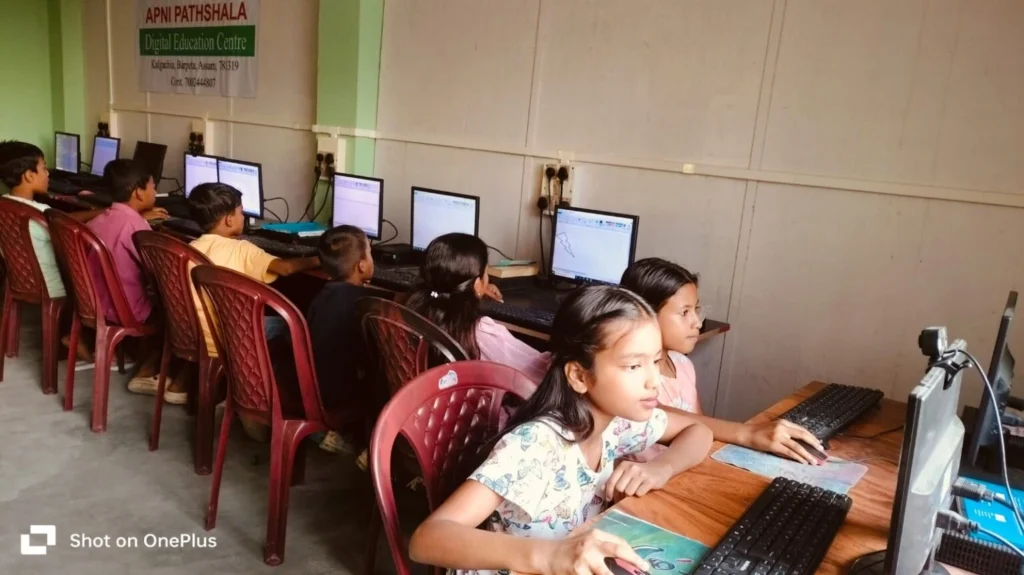
Every parent wants their child to succeed, but let’s be honest: traditional classrooms don’t always make that easy. Maybe your kid comes home frustrated because they didn’t get the help they needed. Maybe they’re bored because they already know the material. Or maybe they feel like just another face in the crowd. Sound familiar? What if there was a better way? Imagine a place where your child gets the attention they deserve, learns at their own pace and feels like they truly belong. That’s what small-group learning in community microschools offers. What Are Community Microschools? So, what exactly are microschools? Think of them as intentionally small learning communities, usually with 5 to 15 students per group. They’re like the perfect mix of homeschooling’s personal touch and traditional education’s structure, all wrapped up in a close supportive community. But here’s the real question: why small groups? It’s simple. Small groups create a space where kids don’t just learn, they grow.It’s a classroom where your child’s voice is always heard, their strengths are celebrated, and their challenges are met with genuine support. That’s the magic of small-group learning. With fewer students, teachers can focus on what matters: building strong relationships, encouraging curiosity, and tailoring lessons to each child’s unique pace. 1. Personalized Attention Have you ever wondered how a teacher with 30 or more kids in the room manages to help everyone? The truth? It’s hard—sometimes impossible. In a smaller group, though, teachers can actually focus on your child’s strengths, challenges, and interests. Here’s what that means for your kid: 2. Building Confidence in a Safe, Nurturing Space Raise your hand if your child has ever been nervous to ask a question in class. It happens all the time in bigger classrooms, where kids worry about being judged or ignored. In a small group, though, kids feel safer. Mistakes become learning moments, not failures. They’re encouraged to ask questions, try new things, and take ownership of their learning. Imagine your child coming home and saying, “I finally got it!” That’s what happens when they’re in a space where they feel comfortable and supported. 3. Stronger Peer Connections and Social Skills In a bigger classroom, it’s easy to feel like just another face in the crowd. But in smaller groups, everyone has a chance to be heard. Kids get to: Take a community microschool, for example. A group of students might be working on a science project, and because the class is small, everyone’s voice counts. They’re able to have real, deep discussions where ideas are shared, and collaboration is key. These types of experiences help kids develop not only academic skills but also social skills that they’ll use for the rest of their lives. 4. Customized Curriculum Here’s the thing: traditional classrooms don’t always have the flexibility to focus on what your child is passionate about. Microschools do. Whether it’s coding, art, science experiments, or even creative writing, small-group learning allows teachers to design lessons around what kids care about. Imagine your child, who’s obsessed with space, spending the day building a model rocket or learning about Mars exploration instead of just reading about it in a textbook. When learning feels meaningful, kids stay engaged—and they grow. 5. Bridging Gaps in Traditional Education We have to be real that not every kid gets what they need in a traditional classroom. Whether it’s falling behind or being left unchallenged, some gaps just don’t get addressed. Microschools fill those gaps by focusing on each child individually. No one slips through the cracks, and every child gets the opportunity to succeed. Is This the Future of Education? It might be. Microschools aren’t just a trend—they’re a solution to the challenges many families face with traditional schooling. Parents want something better for their kids, and microschools offer exactly that: personalized learning, meaningful relationships, and a supportive environment where kids can grow in a better sense. One thing’s for sure: every child deserves an education that meets them where they are, and microschools are leading the way. How to Explore Community Microschools? Curious about community microschools and wondering how to get started? Here are some simple steps to help you: A Brighter Future Ahead The benefits of small-group learning in community microschools go far beyond academics. They nurture confidence, spark curiosity, and help children build meaningful connections—all while providing an education that feels personal and impactful. At the end of the day, every parent wants their child to feel seen, heard, and supported. Microschools make that possible. Your child deserves more than just a good education—they deserve an extraordinary one. Why not start today? And if you’re wondering where to begin, ApniPathshala is here to guide you. With a focus on small-group learning, we create a nurturing environment where every child is seen, heard, and celebrated. At ApniPathshala, we believe that education should be as unique as your child’s. Contact us to learn how we’re redefining learning for the next generation and see the difference a community-driven approach can make.
7 Popular Alternative Education Models | Benefits & Insights
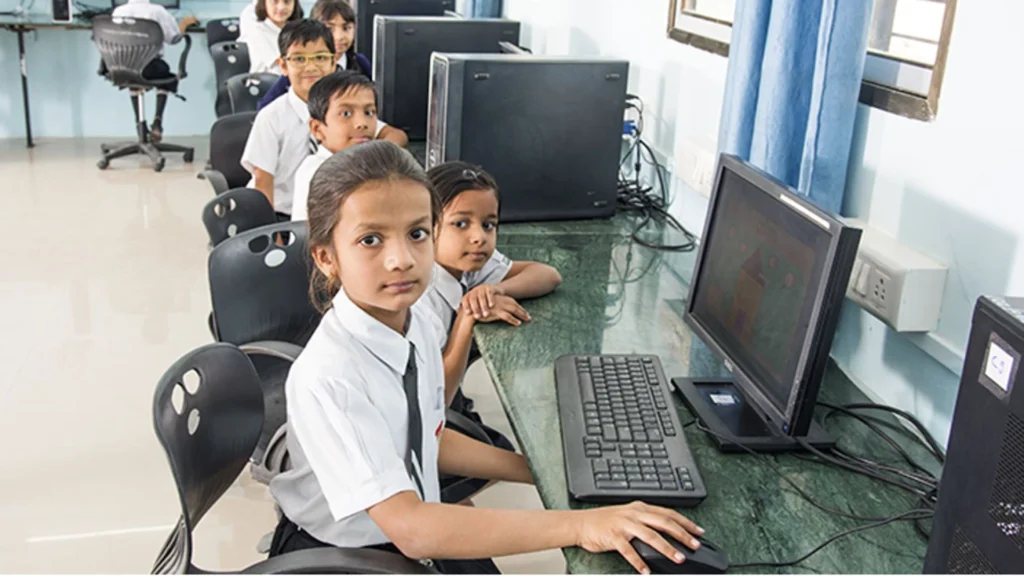
Education is evolving. Children are no more interested in sitting 8-9 hours in a four walled room and studying. With the arrival of technology and access to smart devices (thanks to covid), traditional classrooms have become increasingly less effective for many students. So, the next best option- alternative education models are gaining popularity. These methods allow children to explore their interests, learn at their own pace, and develop skills that prepare them for a changing world. As the name suggests, I’m sure you must have a fair idea of what alternative education is. But, what about the different models? In this blog, we will explore some of the most popular types of alternative education today, explaining their principles and why they might be the right fit for your child. 1. Montessori Education First we have Montessori education. Developed by Dr. Maria Montessori in the early 1900s, it’s one of the most well-known and established forms of alternative education. This approach prioritizes a child’s natural curiosity and promotes self-directed learning. In a Montessori classroom, students are free to choose their activities, which encourages independence, problem-solving, and creativity. What are the benefits of Montessori Education? Montessori schools are present worldwide, from preschools to high schools, and are a popular choice for parents who value flexibility and a personalized education. 2. Waldorf Education Founded by Rudolf Steiner in 1919, Waldorf education aims to educate the whole child—intellectually, emotionally, and physically. Waldorf schools focus on integrating academic subjects with creative arts like music and painting. The goal is to nurture the development of each student, helping them grow into well-rounded individuals. What are the benefits of Waldorf Education? This approach is ideal for families who believe in developing emotional intelligence, creativity, and a deeper connection with nature and the world around them. 3. Reggio Emilia Approach The Reggio Emilia approach originated in Italy after World War II and is centered on the idea that children are competent learners capable of building their own knowledge. In this model, children are encouraged to explore their interests through projects and inquiry-based learning This makes them active participants in their educational journey. What are the benefits of Reggio Emilia Approach? Reggio Emilia has gained international stature, with schools adopting its principles around the world, from the United States to Australia. 4. Homeschooling Homeschooling is one of the most flexible forms of alternative education. Talking about statistics, the number of homeschooled students in India ranges between 500 000 and 2.7 million. And, that is huge! Parents take on the responsibility of teaching their children at home, allowing them to design the curriculum to suit the child’s individual learning style, interests, and pace. This model offers unparalleled freedom and the ability to adapt the educational experience to fit the child’s needs. What are the benefits of Homeschooling? As homeschooling grows in popularity, especially after the global pandemic, it has become an accessible option for many families who want to take a more hands-on approach to education. 5. Online Learning Next we have the most popular form of alternative education- Online Learning. It might be a scary phrase for some of the parents out there, but it is what it is! The rise of technology has made online learning an increasingly viable option for students worldwide. Online education offers the flexibility of learning from home or anywhere with an internet connection. It includes both formal online schools and informal learning platforms offering specific courses or subjects. What are the benefits of Online Learning? Online learning continues to grow, providing an invaluable option for students who need more flexibility or live in remote areas without easy access to traditional schools. 6. Microschools Microschools are small, independent schools that provide personalized education in a community setting. These schools are typically made up of fewer than 150 students and focus on fostering strong relationships between teachers and students. The approach is highly adaptable, allowing for small group instruction and a focus on individual learning needs. What are the benefits of Microschools? Not talking about ApniPathshala while discussing microschools won’t be a right thing to do. This organisation offers a unique approach to education, closely aligned with the principles of microschools. ApniPathshala empowers both parents and students with the flexibility to create a perfect and personalized educational experience. Whether you’re looking for homeschooling options, online resources, or community-driven educational tools, ApniPathshala ensures that every child has the support they need to succeed in their educational journey. If you want to be a part of the journey of providing quality education to kids in every corner, contact ApniPathshala straight away! 7. Project-Based Learning Last but not the least, we have Project-based learning (PBL). It is an educational approach where students work on a project over an extended period, learning about a subject in-depth while solving real-world problems. This practical, student-driven approach encourages critical thinking, collaboration, and creativity. What are the benefits of Project- Based Learning? As educational systems evolve, alternative learning models provide a variety of options for parents and students seeking a more personalized and holistic approach to learning. From Montessori’s self-directed approach to online learning, these alternative educational models cater to diverse learning styles. This overall helps students work and grow in environments that suit their individual needs. Whether you’re looking for an arts-based approach, flexible learning, or learning in small groups, alternative education provides a range of options to help children reach their full potential. As these models continue to grow in popularity, the future of education looks brighter, more inclusive, and adaptable than ever before. If you wanna be a part of a journey that constantly works for the betterment of kids- urban and rural, join hands with ApniPathshala. Let’s make a change together!
Apni Pathshala 2.0: Innovate. Educate. Elevate
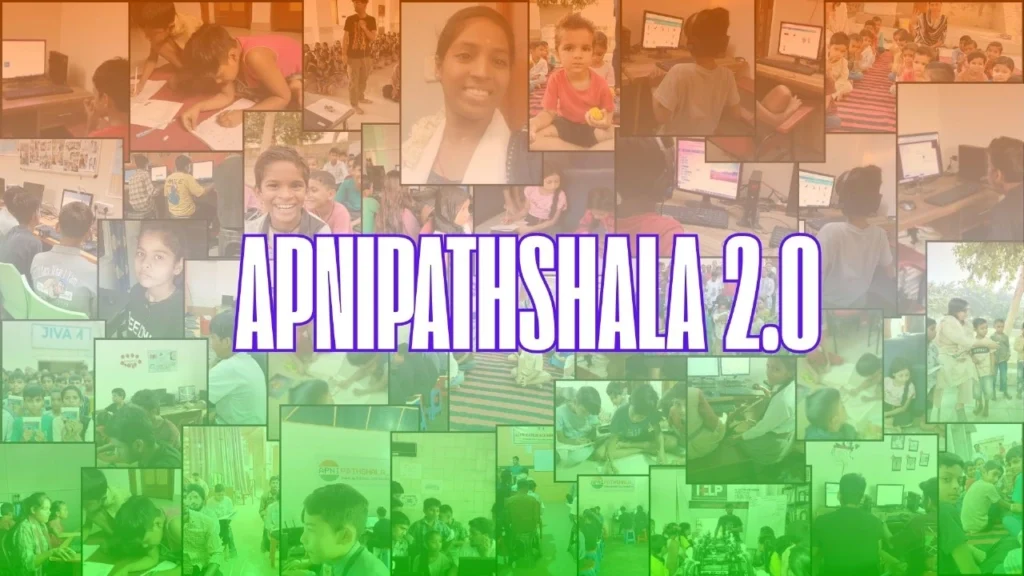
What if we told you there’s a way to bring education to even the most remote communities? A way to make those kids learn coding who don’t even know how to start a computer? A way to help people build skills and become self-reliant? Sounds amazing, right? Well, that’s exactly what Apni Pathshala 2.0 is all about! If you’ve heard of the original Apni Pathshala, you already know it has done amazing work in connecting underprivileged communities with education. But Apni Pathshala 2.0 takes things to the next level. It’s bigger, more organized, and, most importantly, ready to create a lasting impact. Want to know what makes this initiative even more special? What’s Apni Pathshala 2.0 All About? In simple terms, Apni Pathshala 2.0 helps small learning centers, called learning PODs, become powerful hubs of knowledge and digital skills. Over 15 months, these PODs get all the tools and guidance they need to teach students, build websites, and eventually become self-sustainable. Why “2.0”? What’s New? When we first started, Apni Pathshala focused on teaching and sharing updates from PODs. But we realized something important: these learning PODs needed a structured plan to grow and make lasting impact. So, with Apni Pathshala 2.0, we’ve added clear phases, practical goals, and proper timelines. By the end of each phase, we’ll have a proper understanding of each pod’s development and progress. This isn’t just about education anymore, it’s about creating lasting change. Each POD gets personalized support, a step-by-step roadmap, and the tools to make real progress. What’s the Purpose, Goals & Vision? Purpose. First things first, the purpose of Apni Pathshala 2.0 is to create self-sufficient learning centers, known as learning PODs, across India. These are spaces where people can learn digital skills, develop practical abilities, and access education to improve their lives. Goals To achieve this purpose, we’ve set some clear, actionable goals: These goals aren’t just boxes to tick, they’re the foundation of a movement to bring learning and growth to places that need it the most. Vision Now, let’s talk about the dream we’re chasing. We are chasing a future where every community in India has access to a self-sustaining learning center. These centers bridge the gap between those who have access to technology and education and those who don’t. Our vision is to: The Journey: 4 Exciting Phases Phase 0: Getting Started Timeline: Flexible (You decide when you’re ready!)This is where it all begins. We’ll start laying the foundation for your POD’s success. Here’s what happens: By the end of Phase 0, your POD will be equipped and confident to kickstart Phase 1! Phase 1: Building Strong Foundations Timeline: 3 monthsThis phase is all about setting a strong base for your students and POD activities. By the end of Phase 1, your students will be certified in digital skills, and your POD will have a solid online presence! Phase 2: Making Websites Timeline: 3 monthsNow it’s time to take things to the next level. Here the students will learn to create their very own websites! By the end of Phase 2, your students will have real-world skills, and your POD will be quite interactive with all these activities! Phase 3: Independence and Sustainability Timeline: Open-endedThis phase is all about making sure your pod becomes self sustainable and can work with/without you. So that you can watch your POD work and grow independently. By the end of Phase 3, your POD will be fully self-reliant, with a strong community presence and sustainable growth plan! Why Does This Matter? Not everyone has access to good education or technology. Many communities are left behind because they lack resources. Apni Pathshala 2.0 changes this by: The best part? More than learning, it’s about creating opportunities, building independence, and giving people hope. What Happens After Apni Pathshala 2.0? Once Apni Pathshala 2.0 completes its mission of guiding 50 learning PODs through structured phases, don’t you think that journey ends just like that. Over the first six months, PODs move through Phases 0, 1, and 2, with constant support from Apni Pathshala coordinators. The goal is to make sure every POD has the foundation and tools to grow. When a POD reaches Phase 3, it steps into independence. This means they’re ready to operate on their own, managing resources, teaching skills, and staying sustainable without needing external help. While these PODs are moving towards self-sufficiency, the team behind Apni Pathshala is already focused on setting up new PODs. These new learning hubs will go through the initial support stages and eventually join Apni Pathshala 3.0, continuing the cycle of education and empowerment. The process ensures a balance i.e. existing PODs would work independently, while new PODs are nurtured and onboarded. It’s a sustainable system that allows continuous growth and a broader reach. Apni Pathshala 3.0 will take things further, scaling up the network of PODs, mentoring new ones, and creating lasting change. With each new step, the vision of empowering communities through education becomes more real. How Can You Help? This journey isn’t something we can do alone. Whether you’re a teacher, a community leader, or someone who just wants to make a difference, you can play a role. Spread the word, volunteer, or simply support the mission. Together, we can bring the power of education to every corner of the country. Yes, Apni Pathshala 2.0 is about education but more than that it’s about changing lives. This isn’t just a program, it’s a movement. And you can be a part of it.So, what do you say? Let’s Innovate. Educate. Elevate. together!
How Swami Vivekananda Medical Mission and Apni Pathshala Empower Tribal Communities?
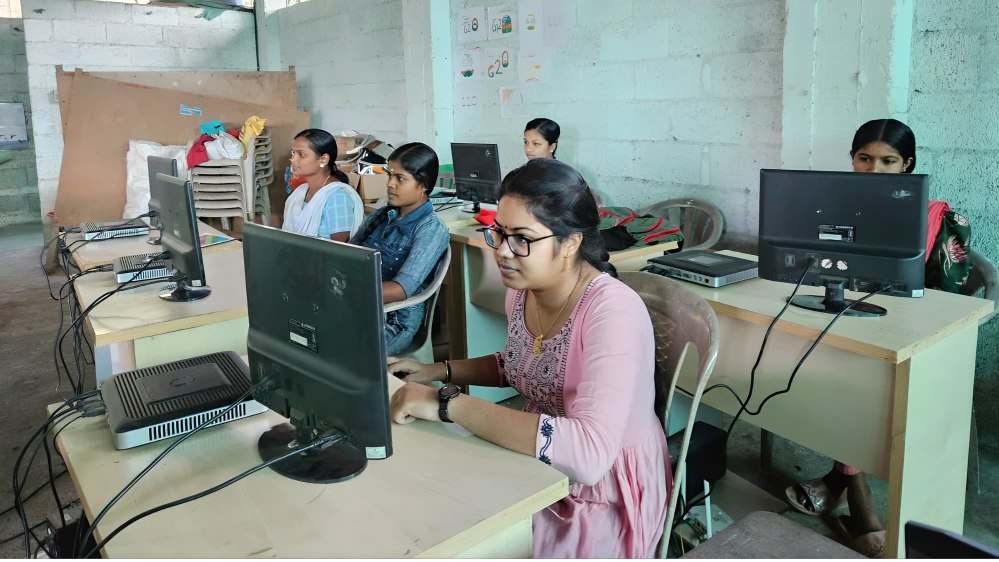
Amidst the quiet hills of Attappady, Kerala, there’s a place that holds a special kind of magic—a place where kindness and hope come together to change lives. This place is the Swami Vivekananda Medical Mission, a foundation that began with a simple yet powerful purpose: to serve those who needed it the most. What started as a small hospital in 2002, offering care to the tribal population, has grown into a fully working community centre focusing on providing education and livelihood. Today, the mission is so much more than just a hospital, it’s a home for hope, a center for learning, and a space where dreams are nurtured. The Heart of the Mission: A Foundation of Care At its core, the Swami Vivekananda Medical Mission has always been about healthcare. The need for affordable medical care in Attappady was urgent—tribal families often couldn’t afford even basic treatments. The healthcare efforts here are nothing less than extraordinary. Dr. Narayan, a doctor who has been with the mission from the start, treats tribal patients for just 10 rupees. Yes, you read that right—10 rupees. It’s not about the money for him. It’s about making sure that no one, no matter how poor or disadvantaged, is left without care. But for Dr. Narayan, it’s not about the money. As per him, health is a basic right and no one should be denied it because they can’t afford it. This value has saved countless lives, offering not just medical care but dignity and respect to those who need it most. Beyond Healthcare By 2009, the SVMM’s work had grown far beyond its original scope. It became an NGO community center, addressing deeper issues like education, women’s empowerment, and even the eradication of social evils like alcoholism. One of the mission’s key focuses today is education. Not just traditional schooling but skill-based learning that raises individuals with tools for self-reliance. Varsha, one of the mission’s dedicated team members, has been active in driving these efforts. Learning and Growing Together Education has become a lifeline for many in this community. But here, education isn’t just about books or degrees, it’s about giving people the tools they need to change their lives. Varsha, a dedicated team member at the mission, shares her experience with a spark in her eyes. “We focus a lot on skill development,” she says. One of their programs is a basic computer education course that runs for a month. Students learn MS Office and other basic skills that open up new opportunities for them. Currently, 35 to 40 students, mostly aged 18 to 35, are enrolled in these programs. During summer vacations, even younger children join in, eager to learn and explore. What’s even more inspiring is that Scheduled Caste (SC) and Scheduled Tribe (ST) students can take these courses for free. But the mission doesn’t stop at education. It also focuses on livelihood programs, helping people find ways to earn a living and support their families. “It’s not just about skills,” Varsha explains. “It’s about showing them that they can dream bigger and achieve more.” What makes the Swami Vivekananda Medical Mission truly unique is its connection with the tribal community. Varsha shares how deeply she’s been touched by their hospitality and respect. “The bond with the tribal population here is so special,” she says. “They don’t have much, but they give so much—kindness, gratitude, and love.” Overcoming Challenges Of course, the journey hasn’t been easy. Attappady is a remote and underdeveloped area, and there are systemic barriers that the mission has constantly faced and most importantly, overcame. One of the most heartbreaking challenges, Varsha says, is the limited opportunities for women. “Many women here aren’t allowed to study after marriage,” she shares. “It’s a barrier that holds them back from reaching their potential.” Despite these hurdles, the mission refuses to give up. Each obstacle is a reminder of why their work matters so much. They know that change doesn’t happen overnight, but they also know that every small step forward counts. Apni Pathshala: A Helping Hand One of the most beautiful parts of this story is the partnership between the Swami Vivekananda Medical Mission and Apni Pathshala. At a time when the mission was struggling with funding, Apni Pathshala stepped in and donated 10 computers. “It was a turning point for us,” Varsha recalls with gratitude. “With their support, we were able to expand our programs and give students here the chance to learn skills that can truly change their lives.” This partnership is about belief. Apni Pathshala believed in the mission and its vision, and that belief has made all the difference. Dreaming of a Brighter Tomorrow The Swami Vivekananda Medical Mission not only works for today, but is building a better future. Varsha talks about the mission’s vision with so much passion. “We want people to step out of their shell,” she says. “So many people here don’t even know what’s possible beyond their community. Our job is to make them aware. To show them that there’s a whole world of opportunities waiting for them.” The mission dreams of introducing vocational courses and reaching even more people. But for them, success isn’t measured in numbers. “If even one person benefits from what we do, it’s a win,” Varsha says, her voice filled with emotion. A Message That Stays With You As we reached the end of our conversation, Varsha shared a message that felt like it came straight from the heart. “If you’re privileged enough to help someone,” she said, “just do it. Don’t overthink it. Even the smallest act of kindness can change someone’s life.” The Swami Vivekananda Medical Mission isn’t just a place, it’s a feeling. It’s the hope that no matter how tough life gets, there’s always someone willing to help. It’s the belief that every person deserves a chance to dream, learn, and grow. With dedicated people like Dr. Narayan and Varsha, and the relentless support of partners like Apni Pathshala, the mission continues
How do learning pods support working parents?

Balancing the demands of work and parenting can be overwhelming, especially in today’s world, where both parents are working. But, with the launch of learning pods, working parents now have a solution that provides flexibility, personalized learning, and better education for their kids. To know more about how learning pods support working parents, have a look at this article. What are learning pods? First things first, what are learning pods? They also known as micro-schools or pandemic pods, are small, organized groups of students who come together to learn in a more personalized and collaborative setting. These pods offer several key benefits, including: While learning pods became popular during the COVID-19 pandemic, they’ve grown into a long-term option for families seeking a more customized learning experience. Now, let’s see how learning pods would benefit working parents. 1. Flexible Schedule and Work-Life Balance First benefit is flexibility. Learning pods for working parents offer a major advantage in terms of flexibility. Traditional schools operate on fixed schedules, but learning pods allow parents to choose learning hours that best suit their workday. By participating in flexible learning pods, working parents don’t have to sacrifice one priority for the other. 2. Personalized Learning Experience for Children Another key benefit of learning pods is the ability to provide a personalized learning experience for each child. In traditional classrooms, a teacher cannot pay close attention to all 45 students in the class. Let’s be honest, it’s not even possible. And this is the major reason parents are stressed about their child’s education. However, in learning pods, where the size of each class isn’t very big, the teacher can focus on each child’s specific needs. And this individual attention towards kids can help relieve the stress from working parents. 3. Increased Control Over the Learning Environment Parents in learning pods have more control over the learning environment compared to traditional schools. This is especially beneficial for parents of children with special needs or learning differences. This level of control helps working parents feel assured that their child is receiving the best possible education. 4. Reduced Stress and Increased Work Productivity Learning pods are a great solution for working parents who manage both their jobs and their kids’ education. These learning pods can ease the stress of constantly supervising schoolwork, leading to better focus and productivity at work. By using a learning pod, parents can regain control of their workday, which also has a positive impact on their mental health and overall well-being. It’s a win-win for both parents and kids! Doesn’t that sound interesting? 5. Building a Stronger Community Learning pods induce a sense of community and collaboration among families. Parents come together to share resources, responsibilities, and even childcare. For working parents, this shared responsibility helps lighten the load and creates a more sustainable way to manage both work and family life. 6. Enhanced Social Interaction for Children Another major advantage of learning pods is the social interaction they provide for children. Unlike remote learning, which can feel isolating, learning pods give kids the chance to engage with peers in a safe, small-group setting. This mix of learning and socializing is great for children’s development and relief for working parents, who can feel confident their kids aren’t missing out on essential growth. For parents, this is a big relief. Knowing their children are getting the social interaction they need means less worry about their development. It also frees up parents to focus more on their work, as they don’t have to constantly supervise or find ways to keep their kids engaged. Learning pods offer peace of mind, making it easier for working parents to balance both work and family life. 7. Safe Learning Environment in Uncertain Times The COVID-19 pandemic proved to everyone the need for safe and controlled learning environments. It told everyone how important it is to make sure the kids are safe and that they should not be stuffed in a classroom just to show a high no. of students. With schools closing or moving online, learning pods provided a safe learning alternative during times of uncertainty. Working parents, especially those in essential industries, found peace of mind knowing their children were still receiving an education in a safe environment. How do Apni Pathshala’s Learning Pods help working parents? At Apni Pathshala, we get how tough it can be for working parents to manage everything. That’s why our learning pods are designed to offer the flexibility, personal attention, and community support that modern families need. With qualified educators and a customized curriculum, Apni Pathshala’s learning pods provide a perfect solution for parents who want the best education for their children while managing their careers. Here’s how we help: At Apni Pathshala, we are dedicated to supporting working parents with innovative learning solutions that benefit both children and families. If you’re a working parent looking for a way to manage both your professional and parental duties, consider enrolling your child in a learning pod. With the right structure and support, it’s the perfect solution for your family’s needs. For more information on how Apni Pathshala’s learning pods can help you and your child, visit us today!
Discover New Teaching Strategies At Learnscape Summit
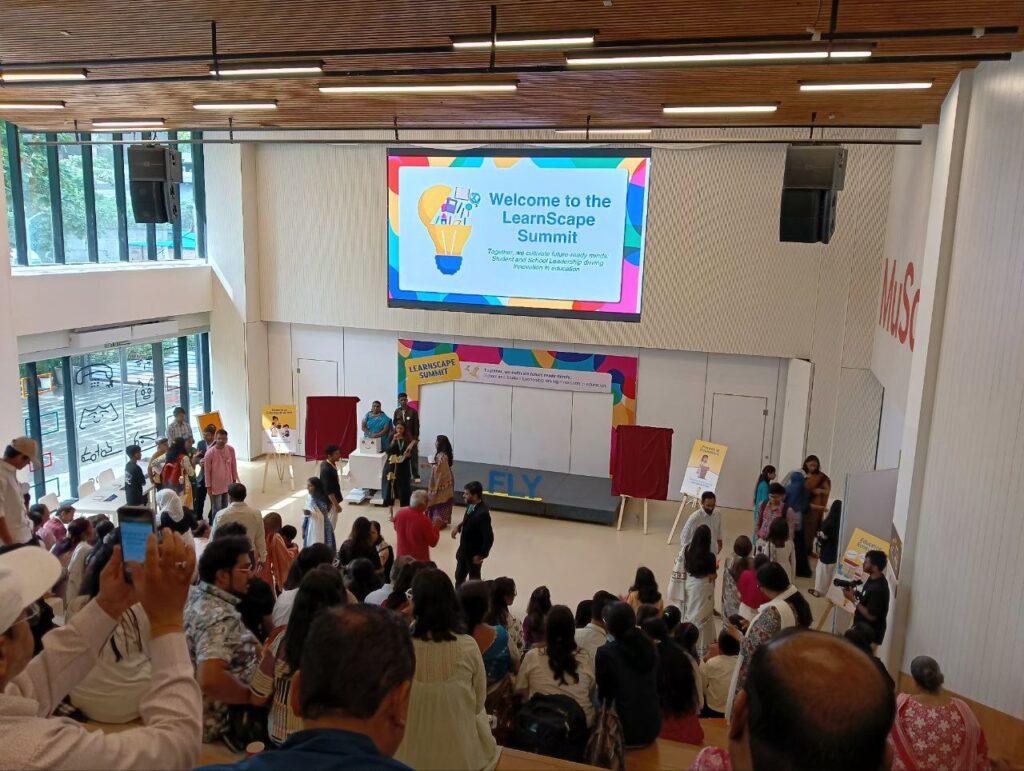
Innovative Educational Practices Unveiled at the Learnscape Summit On 25th June 2024, our team had the privilege of attending the Learnscape Summit led by the Barefoot organization. This event was a treasure trove of insights into innovative educational practices, showcasing multiple programs that could revolutionize the way we approach education. About Unifly Organization Unifly is a nonprofit organization dedicated to collaborating with principals and teachers, who they refer to as School Leaders. Their primary operations are based in Delhi and Mumbai, where they strive to create interactive and engaging classroom environments. Rather than focusing on tech-related solutions and traditional curricula, Barefoot emphasizes hands-on and community-centric approaches. Their methods include painting numbers and tables on walls, and displaying maps on doors to make learning more tangible and accessible. Key Observations One of the most striking aspects of Unifly approach is its community-centric and impactful nature. Unlike other organizations, Barefoot uses specific terminology such as cohorts, school leaders, and clubs to foster a sense of community and collaboration. Instead of providing alternative learning solutions, they address gaps within the existing educational system by volunteering in schools and assisting teachers with extracurricular activities. Highlighted Projects and Initiatives Unifly dedication to innovation is evident through several key projects and initiatives: Project BALA (Building as Learning Aid) Project BALA connects individuals from various professions, transforming them into school leaders. Some participants even become educators. This project is known for its creative teaching methods, such as painting walls to teach history and grammar. It exemplifies how learning can be made more interactive and enjoyable. Innovative Pitching and Competition System Barefoot has introduced an innovative competition system for school principals with groundbreaking ideas to develop their schools. Winners receive funding to implement their ideas, fostering a spirit of innovation and practical implementation. This concept is something that Apnipathshala could potentially adopt to enhance its impact. STEAM (Science, Technology, Engineering, Arts, Mathematics) The STEAM initiative involves an innovative tinkering lab system designed to teach these subjects in a practical and engaging manner. By incorporating hands-on activities, students can better grasp complex concepts and develop a love for learning. Pehli Shikshak Maa This initiative emphasizes the critical role of parents, especially mothers, in the education system. It encourages parental involvement and recognizes the influence of a supportive home environment on a child’s educational journey. Project Pioneer and Thoughtful Thinking Thoughtful Thinking is an initiative that introduced the concept of a parent and student report card. This allows parents to report on their child’s personal growth, while students reflect on their progress. It’s a holistic approach to tracking development, fostering self-awareness and parental engagement. Conclusion The Learnscape Summit provided us with numerous innovative ideas and practices that we can integrate into our own programs at Apnipathshala. By adopting similar strategies, we can enhance our impact and further support the development of schools and educators. The event highlighted the importance of community-centric approaches, creative teaching methods, and parental involvement in education. Meeting with Barefoot Co-founders During the summit, we had the opportunity to meet with the co-founders of the Barefoot organization. A follow-up meeting is tentatively scheduled with Johnathan, one of the co-founders, to discuss potential collaborations and gain further insights. This meeting holds the promise of strengthening our partnership and sharing best practices. Action Items To make the most of the insights gained from the Learnscape Summit, we have outlined several action items: By taking these steps, we can ensure that Apnipathshala remains at the forefront of educational innovation, supporting schools and educators in meaningful and impactful ways.
Smart Time Management Tips for Tech Students
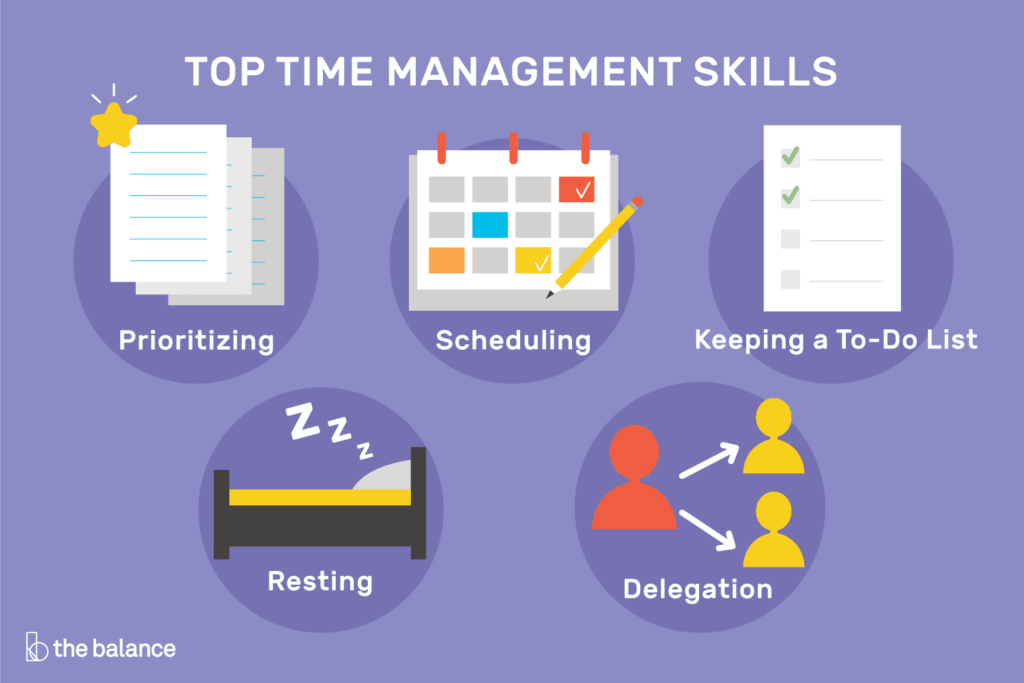
Time Management Magic: A Must-Have Skill for Tech Students Hey fellow tech enthusiasts! Today, we’re diving into a superpower that every tech student should have – time management. It’s like the secret sauce for success in the tech world. Let’s break it down into simple steps so you can rock your studies and still have time for all your favorite things. The Power of Planning: Imagine having a superhero planner. Well, you can! Start your day by making a to-do list. Write down what you need to study, any assignments, and even time for breaks. It’s like having a roadmap for your day. Break It Down, Tech Style: Tech is all about breaking big problems into smaller, manageable parts. Apply the same principle to your studies. Instead of staring at a mountain of code, break it down into smaller tasks. It’s like solving puzzles – one piece at a time! Say Hello to Prioritization: Not all tasks are created equal. Some are like VIPs, needing your attention first. Identify the most important tasks and tackle them first. It’s like being the captain of your study ship, steering it in the right direction. The Pomodoro Technique – Your Study Buddy: Ever heard of the Pomodoro Technique? It’s a time management trick where you work for 25 minutes, then take a 5-minute break. Repeat. It’s like a mini hack for keeping your brain focused and ready to tackle anything. Embrace Tech Tools: Tech students, rejoice! There are awesome apps and tools out there to help you manage time. From calendars to task management apps, find what works for you. It’s like having your very own tech sidekick! Learn to Say ‘No’ (Sometimes): Tech students often want to conquer the tech world in one day. But guess what? It’s okay to say ‘no’ to extra tasks sometimes. Focus on what’s essential, and it’s like giving yourself the gift of time. Celebrate Small Wins: Every line of code, every solved problem – celebrate it! It’s like leveling up in a game. Acknowledge your achievements, no matter how small. It keeps you motivated for the bigger challenges. Conclusion: Mastering time management is your ticket to success in the tech universe. It’s not about having more time; it’s about using the time you have wisely. So, fellow techies, gear up, use these simple tricks, and conquer your tech journey like the superheroes you are. Time to code on! 🚀💻
